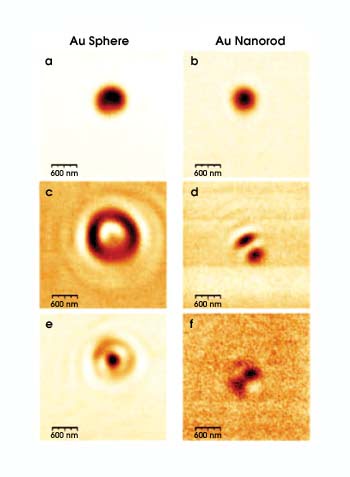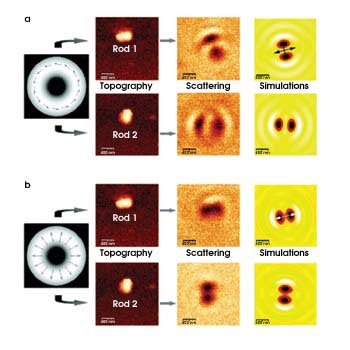
Images Reveal Shape, Orientation of Nanoparticles
Daniel S. Burgess
Using a variant of confocal microscopy that illuminates samples with higher-order laser modes, investigators at Universität Tübingen in Germany have produced images of gold nanospheres and nanorods that offer information about both the shape and the orientation of the structures. They propose that the technique may find application in the biological sciences for the detection of these nonbleaching, biocompatible labels.

Unlike scattering images of a gold nanosphere and nanorod produced using a linearly polarized Gaussian laser beam (a and b), those generated with azimuthally (c and d) and radially (e and f) polarized doughnut modes differ from the geometry of the nanostructures. Images reprinted with permission of Nano Letters.
The approach makes use of the fact that the geometry of metallic nanoscale structures determines how they affect local electromagnetic fields through the action of plasmons, optical excitations coupled with oscillations of conduction electrons in the structures. Specifically, nanospheres feature one plasmon band that is defined by their diameter, while nanorods feature two bands that are defined by their length and width. The two types of nanoparticles thus display unique responses to polarized illumination, which enables researchers to distinguish the structures by their respective scattering patterns under different polarizations and to determine the orientation of a rod by comparing the magnitudes of the scattering under various polarizations.

By comparing the scattering images of gold nanorods generated using azimuthally and radially polarized doughnut modes (a and b, respectively) with atomic force micrographs and with simulations, the researchers can estimate the orientation of the structures in a 2-D plane to within 5° using one scattering pattern.
The scientists discovered that using a polarized laser beam with a doughnut-shaped profile for illumination is a more efficient means of interrogating the structures, requiring only a single image. In their demonstration, they characterized commercially available gold spheres with diameters of approximately 20 nm and gold rods with widths of 12 to 15 nm and lengths of 30 to 45 nm that they produced in the lab. They employed a homebuilt inverted confocal microscope, using a linearly polarized HeNe laser as the excitation source. The 632.8-nm light passed through a polarization converter with four λ/2 plates in each quadrant, rotated 90° with respect to each other, and a spatial filter to produce azimuthally and radially polarized laser modes.
The investigators determined that the scattering patterns from the nanospheres display nearly perfect radial symmetry under either polarization, while those from the nanorods display a double-lobed structure that rotates with the polarization, confirming that the type of nanostructure may be determined using one scattering pattern. Noting that the plasmon resonance of the long axis of the nanorods at this wavelength is at least an order of magnitude stronger than that of the short axis, they found that they could establish the orientation of those structures in a 2-D plane to within 5° using one scattering pattern.
The scientists suggest that using a radially polarized beam to produce an additional scattering image will enable them to determine the orientation of a gold nanorod in three dimensions.
Nano Letters, July 2006, pp. 1374-1378.
Published: September 2006